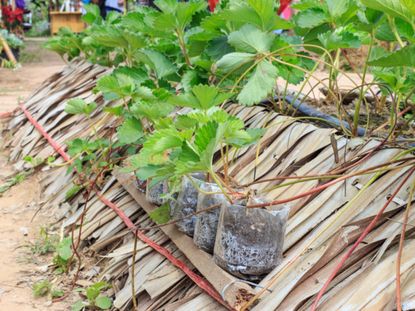Growing Strawberry Runners: What To Do With Strawberry Runners


Got strawberries? Want some more? It's easy to grow additional strawberry plants for yourself, friends, and family through strawberry propagation. So if you've ever wondered what to do with strawberry runners, wonder no more.
What are Strawberry Plant Runners?
Most varieties of strawberries produce runners, also known as stolons. These runners will eventually develop their own roots, resulting in a clone plant. Once these adventitious roots establish in the soil, the runners begin to dry up and shrivel away. For this reason, using strawberry plant runners for propagation makes it especially easy to make more plants.
When to Cut Strawberry Runners
Since many people choose to pinch out runners in order to allow plants to concentrate their energy on making large fruits, you can cut them off as they appear and pot them up rather than simply tossing them. However, most people think late summer or fall is an ideal time for when to cut strawberry runners, just prior to winter mulching. Basically, anytime between spring and fall is okay as long as the runners have produced adequate root growth. Strawberry plants usually send out a number of runners, so choosing some for cutting shouldn't be too difficult. Depending on how many you want to grow, three or four should be good to start with. Carefully pull each runner away from the mother plant. Keep the closest runners to the mother plant for propagating, as these are the strongest and pinch out and discard those that are the furthest away.
Growing Strawberry Runners
While you can leave the runners to root where they are, it usually helps to let them root in a container of their own so you won't have to dig up the new plant later. Again, this is personal preference. If you choose to root in a pot, go with something about 3 to 4 inches (8-10 cm.) in diameter. Fill the pots with moist peat and sand and then sink them into the ground near the mother plant. Lay each runner on top of the potting medium and anchor in place with a rock or piece of wire. Water thoroughly. Then in about four to six weeks there should be enough root growth to clip them away from the mother plant. You can them remove the pot from the ground and give the plants away to others or transplant them to another location in the garden.
Gardening tips, videos, info and more delivered right to your inbox!
Sign up for the Gardening Know How newsletter today and receive a free download of our DIY eBook "Bring Your Garden Indoors: 13 DIY Projects For Fall And Winter".

Nikki Tilley has been gardening for nearly three decades. The former Senior Editor and Archivist of Gardening Know How, Nikki has also authored six gardening books.
-
 Elegant Exotics: 8 Beautiful Amaryllis Varieties That Will Brighten Any Holiday Display
Elegant Exotics: 8 Beautiful Amaryllis Varieties That Will Brighten Any Holiday DisplayWhether red, pink, white or variegated, the right amaryllis varieties can enhance any living space, especially during the holidays. We round up eight of the most exquisite
By Bonnie L. Grant
-
 Forage For Herbs: 7 Tasty And Safe Wild Herbs To Pick Close To Your Own Backyard
Forage For Herbs: 7 Tasty And Safe Wild Herbs To Pick Close To Your Own BackyardIn addition to growing your own herbal staples, did you know there are several wild options out there that are safe and tasty – and free? Try foraging these 7 wild herbs
By Amy Grant